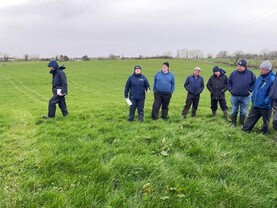It may seem strange to be discussing silage quality when many later-lambing farms are still feeding silage.
Concentrate costs are the largest variable cost on many farms, with this partly due to higher volumes being fed to compensate for lower silage quality.
As detailed on this week’s sheep pages, the focus at present for many is keeping enough grass ahead of ewes, but plans should still be in place to ensure good-quality silage is made.
There are numerous factors that will influence quality, including harvest date, sward type, length of the growing period, etc.
Table 1 details the recommended volume of nitrogen (N), phosphorus (P) and potassium (K), as per Teagasc advice, for first-cut silage based on a reseed or relatively new sward and producing 5t DM/ha.
Teagasc advice for swards with lower yield potential is to reduce N, P and K allocations by 25kg N, 4kg P and 25kg K per tonne of grass dry matter typically produced.
Practical advice
In practical terms, the advice is generally to apply up to 100 units of nitrogen on reseeded or young productive pastures. This can be reduced to 70 to 80 units per acre on less productive swards.
Under normal growing conditions, grassland swards will utilise in the region of two units of nitrogen per day. This should also be borne in mind for farms planning early cutting dates and applying fertiliser for silage in the coming week.
Some farmers who are particularly tight on grass early in the year due to a high stocking rate often operate a system of applying 30 to 40 units of nitrogen on grazing ground at this stage of the year without closing a large area for silage.
They then work on the premise of taking surplus grass out of the rotation when growth really gets motoring and save high-quality winter forage in that manner.
Read more
Making good quality silage
It may seem strange to be discussing silage quality when many later-lambing farms are still feeding silage.
Concentrate costs are the largest variable cost on many farms, with this partly due to higher volumes being fed to compensate for lower silage quality.
As detailed on this week’s sheep pages, the focus at present for many is keeping enough grass ahead of ewes, but plans should still be in place to ensure good-quality silage is made.
There are numerous factors that will influence quality, including harvest date, sward type, length of the growing period, etc.
Table 1 details the recommended volume of nitrogen (N), phosphorus (P) and potassium (K), as per Teagasc advice, for first-cut silage based on a reseed or relatively new sward and producing 5t DM/ha.
Teagasc advice for swards with lower yield potential is to reduce N, P and K allocations by 25kg N, 4kg P and 25kg K per tonne of grass dry matter typically produced.
Practical advice
In practical terms, the advice is generally to apply up to 100 units of nitrogen on reseeded or young productive pastures. This can be reduced to 70 to 80 units per acre on less productive swards.
Under normal growing conditions, grassland swards will utilise in the region of two units of nitrogen per day. This should also be borne in mind for farms planning early cutting dates and applying fertiliser for silage in the coming week.
Some farmers who are particularly tight on grass early in the year due to a high stocking rate often operate a system of applying 30 to 40 units of nitrogen on grazing ground at this stage of the year without closing a large area for silage.
They then work on the premise of taking surplus grass out of the rotation when growth really gets motoring and save high-quality winter forage in that manner.
Read more
Making good quality silage






 This is a subscriber-only article
This is a subscriber-only article










SHARING OPTIONS: